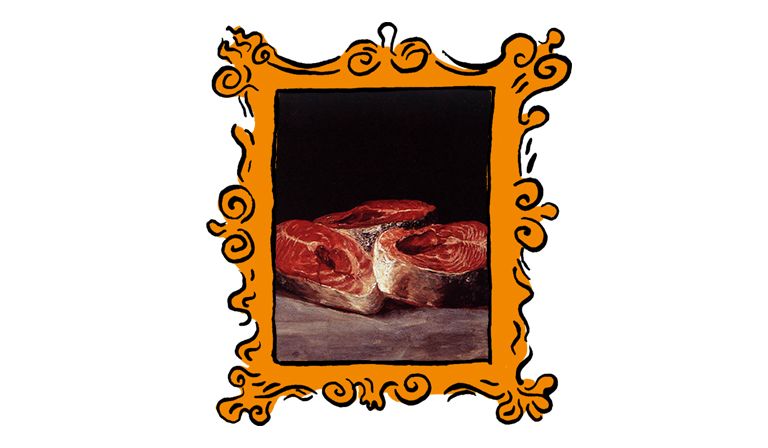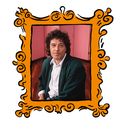Here’s a question: when is a salmon more than a salmon? Answer: when it’s a sublime stand-in for war and suffering—as per Francisco de Goya’s painting Still Life with Three Salmon Steaks (1808-12). The work is one of 25 on loan to London’s Courtauld Institute from the Oskar Reinhart Collection, while its home in the Am Römerholz Villa in Winterthur, Switzerland, undergoes repair work. This still life was “produced during the Peninsula War in Europe while Goya was in Madrid,” explains Barnaby Wright, deputy head of the Courtauld, “when his household was forced to have a French officer billeted in residence.” Goya’s depiction of raw salmon, with its visceral blood rivulet, was a canny front for political themes; prizing it demonstrated Reinhart’s own canny collecting eye. And when collectors bequeath their prizes to the public, as Reinhart did, we all reap the benefits.
The Courtauld is an apt context for showing Reinhart’s works; the Swiss collector and the Institute’s founder, Samuel Courtauld, were contemporaries, even meeting once. Each warmed to the way Impressionism didn’t require a classical education of its viewers. Each believed in the power of art as a civilising force in society—and put their money where their mouths were. Reinhart donated 600 works to the Winterthur Museum in his lifetime (to which his father, Theodor, had donated a wing) and later bequeathed his home to the state. Courtauld left his “collection of collections” to a new publicly accessible institute, while the Courtauld Fund helped acquire works that are now part of the National Gallery.
History is full of private collectors and individuals, like Courtauld and Reinhart, who have fundamentally shaped how we experience art—even down to deciding, quite literally, what art we get to see. Take the famous disappearance of Vincent van Gogh’s Portrait of Dr Gachet (1890). In 1990, records were set at Christie’s when this spectacular, much-loved work—considered by some as one of Van Gogh’s best—was bought by a Japanese paper magnate for $82.5m, the largest amount of money for a painting on record. Changing hands multiple times, nine years later it disappeared entirely from public view. The Städel Museum in Frankfürt, where it once hung, spent years finding out where it had gone. It was finally rediscovered and returned to a public collection in 2019, only now this time at the Musée d’Orsay.
Yet for every collector who has taken work out of public view there are many who have done the opposite—like, say, one Oskar Reinhart. In 1889, Van Gogh painted only two pictures of the Arles hospital where he underwent treatment after severing his ear: The Courtyard of the Hospital at Arles and The Ward in the Hospital at Arles. Despite being described by the artist as a pair, they were sold and split up in the 1890s after his death. Reinhart bought the former in 1922 and the latter in 1925, finally reuniting them. They’ve been together—and on show—ever since.
Today, philanthropic collectors are still around: there’s tech billionaire Hasso Plattner and his “gift to the city”, Museum Barberini in Potsdam, or the Bourse de Commerce in Paris housing much of businessman François Pinault’s vast collection. But the financial stakes are undoubtedly higher in the 21st century, meaning the line between public benefit and private self-interest is much harder to gauge. Sometimes, the incentive is obvious: in the United States, for example, opening a private museum comes with tax breaks. Often, though, things are murkier, particularly when the public sector is involved. Acceptance into a major public museum can inflate an artist’s market value—including any related private works owned by collectors—and often it is collectors themselves who sit on museum acquisition boards and directly influence those decisions.
Sometimes, a collector’s influence can be such that they don’t even need to go as far as that. When Charles Saatchi partnered with the Royal Academy of Arts to stage an exhibition of the Young British Artists in 1997, he was cementing the critical esteem of a group he had already spent many years collecting and promoting—including at his own exhibition of their work at his eponymous gallery in 1985—and scored a healthy return on his investment in the process.
“The need for philanthropy has been increasing over the last decade or so,” says Wright, alluding to cuts in government funding for public institutions. “It’s the job of museums and galleries to be alert to potential dangers. There’s a way of negotiating those waters. There is always somebody at stake in writing up our cultural history, and it’s about challenging those biases rather than having them handed on as an absolute.”
Though many collectors could do worse than learn from Reinhart. The ultimate cultural trainspotter nerd, he approached his “profession” seriously—his goal was to polish his collection into a Gesamtkunstwerk, or “total work of art”. But he also had a sense of humour: wandering incognito among visitors to his Am Römerholz Villa, he would listen in on what they had to say about the works. These days, there’s nobody to eavesdrop as you wonder around the villa. But in one corner, Reinhart’s bust—which uncannily resembles Alfred Hitchcock—is still presiding over affairs.
What private collectors mean for art
Wealthy people have influenced the cultural marketplace for centuries. Sometimes they wield that influence in dubious ways—but not always
March 20, 2025

Goya’s ‘Still Life with Three Salmon Steaks’








